When most travelers think of Cusco, Machu Picchu and the Sacred Valley come to mind. But for birdwatchers, Cusco is something else entirely: a living paradise where the Andes meet the Amazon, creating one of the most diverse ecosystems on Earth. With over 1,000 bird species recorded in the region, Cusco is a dream destination for birding enthusiasts.
From high Andean lakes to lush cloud forests and tropical lowlands, Cusco offers a chance to see everything from dazzling hummingbirds to rare endemics found nowhere else in the world. This guide explores the best birdwatching spots in Cusco, what species you can expect, and practical tips for planning your trip.
1. Huacarpay Wetlands – A Perfect Introduction to Andean Birding
Location: 30 km southeast of Cusco (about 30–40 minutes by car).
Altitude: 3,050 m
Recommended time: 1 day – 1/2 day
The Huacarpay Lagoon is one of the most accessible birding sites near Cusco. Surrounded by Inca and pre-Inca archaeological sites, this wetland offers a blend of cultural and natural exploration.
Just a 40-minute drive from Cusco, the high Andean lagoons and marshes of Huacarpay offer one of the easiest and most rewarding birdwatching excursions near the city. Despite their gradual decline, these wetlands remain an excellent spot to spend a morning or afternoon observing typical Andean waterfowl and some remarkable endemic species.
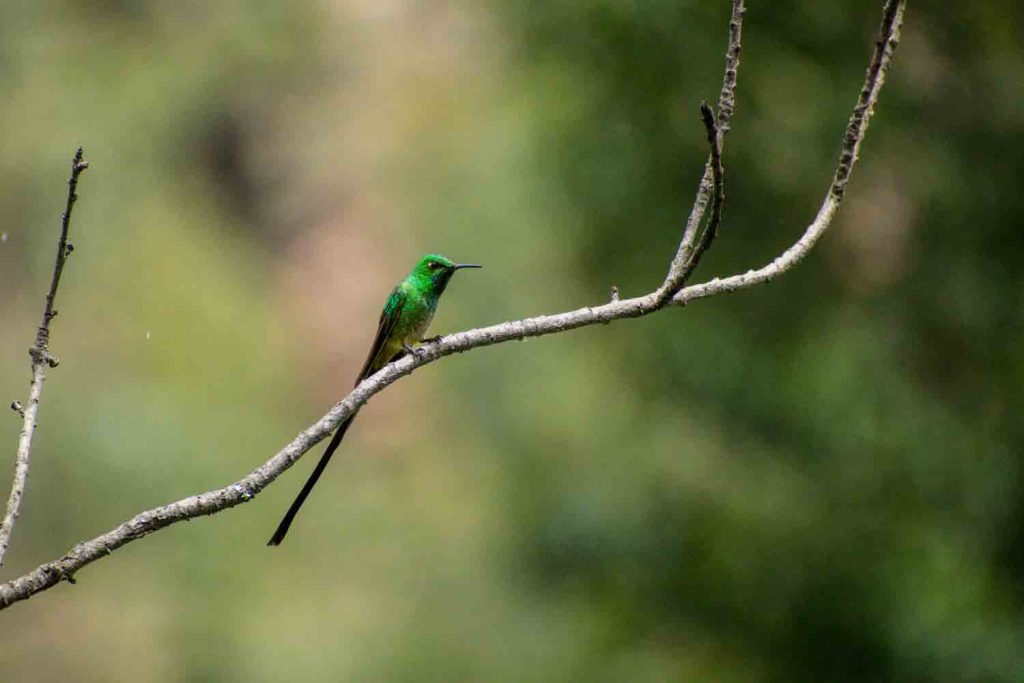
Among its highlights is the Bearded Mountaineer, a striking endemic hummingbird found almost exclusively in this region. It frequents the yellow tubular flowers of local tobacco bushes, providing great viewing opportunities for birders and photographers. Huacarpay is considered one of the most reliable places to spot this unique species.
The area is also home to the impressive Giant Hummingbird and the Green-tailed Trainbearer, though both are often overshadowed by the dazzling Bearded Mountaineer. Birders are encouraged to explore the circuit around the lake, paying attention not only to the water but also to the arid scrubland across the road.
Above the wetlands, near the ancient ruins overlooking the lake, you might find the Rusty-fronted Canastero, another Peruvian endemic. On the far side of the lagoon, the large pond near Urpicancha—which has a small restaurant and flower gardens—often attracts Silvery Grebes, Puna Teals, and various hummingbirds.
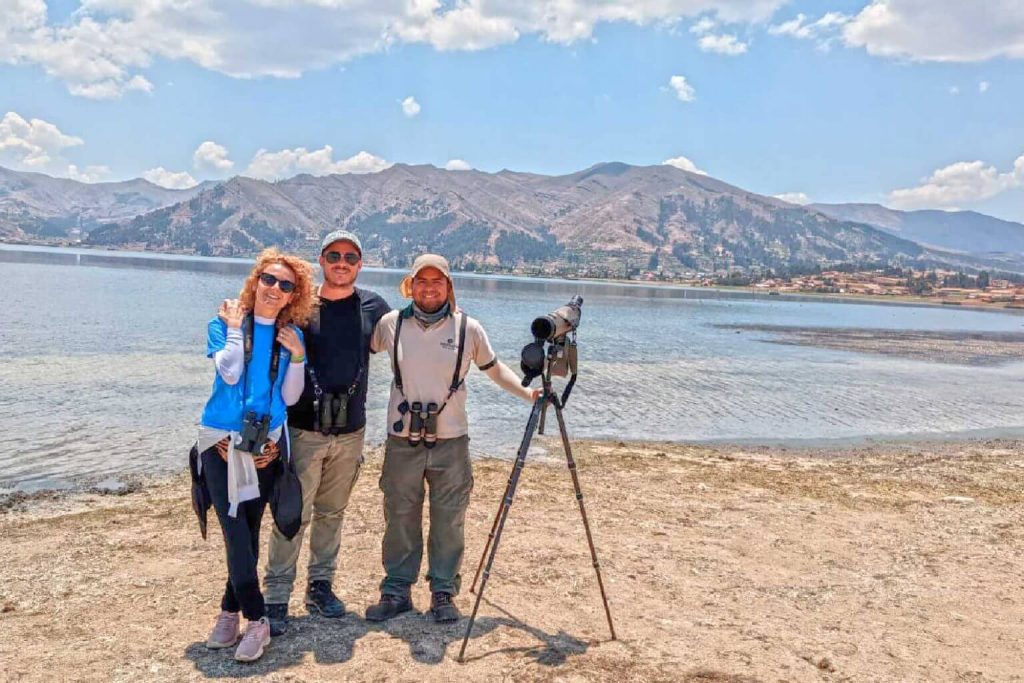
Huacarpay lies conveniently along the routes from Cusco to Manu and from Cusco to Puno, making it an easy and worthwhile stop for travelers interested in Andean birdlife.
Common species: White-tufted Grebe, Silvery Grebe, Andean Duck, Cinnamon Teal, Puna Teal, Yellow-billed Pintail, Plumbeous Rail, Andean Gull, Giant Hummingbird, Bearded Mountaineer, Rufous-naped Ground-Tyrant, Andean Negrito, Yellow-winged Blackbird.
Occasional visitors: Green-tailed Trainbearer, Rusty-fronted Canastero, Streak-fronted Thornbird, Golden-billed Saltator.
Key Bird Species
- Bearded Mountaineer
- Rusty-fronted Canastero
- Chestnut-breasted Mountain Finch
- Yellow-winged Blackbird
- Many-colored Rush Tyrant
- White-tufted Grebe
- Plumbeous Rail
- Migratory species (September–April), including sandpipers and plovers.
Why Visit
- Easy half-day trip from Cusco.
- Combines birding with cultural history.
- Great for photographers thanks to open landscapes and reflections in the water.
2. Abra Málaga – Where the Andes Meet the Cloud Forest
Location: Road to Quillabamba, ~150 km from Cusco.
Altitude: 4,216 m at the pass.
Recommended time: 1-3 days
Abra Málaga is one of the most famous birdwatching passes in Peru. On the western slope you find high Andean puna grasslands, while the eastern slope descends into lush cloud forests. This dramatic gradient allows birders to see an incredible mix of species in a single day.
Made famous decades ago by the legendary ornithologist Ted Parker, Abra Málaga remains one of the most iconic birding destinations accessible from Cusco. Although the Manu Road has gained more popularity in recent years, Abra Málaga continues to be an essential stop for birdwatchers, offering unique species that are not found elsewhere in southern Peru.
The area preserves patches of Polylepis forest, one of the world’s most threatened ecosystems, which still shelters several highly specialized and endemic species. These relic forests, together with the surrounding puna grasslands and montane scrub, make Abra Málaga an exceptional place to explore.
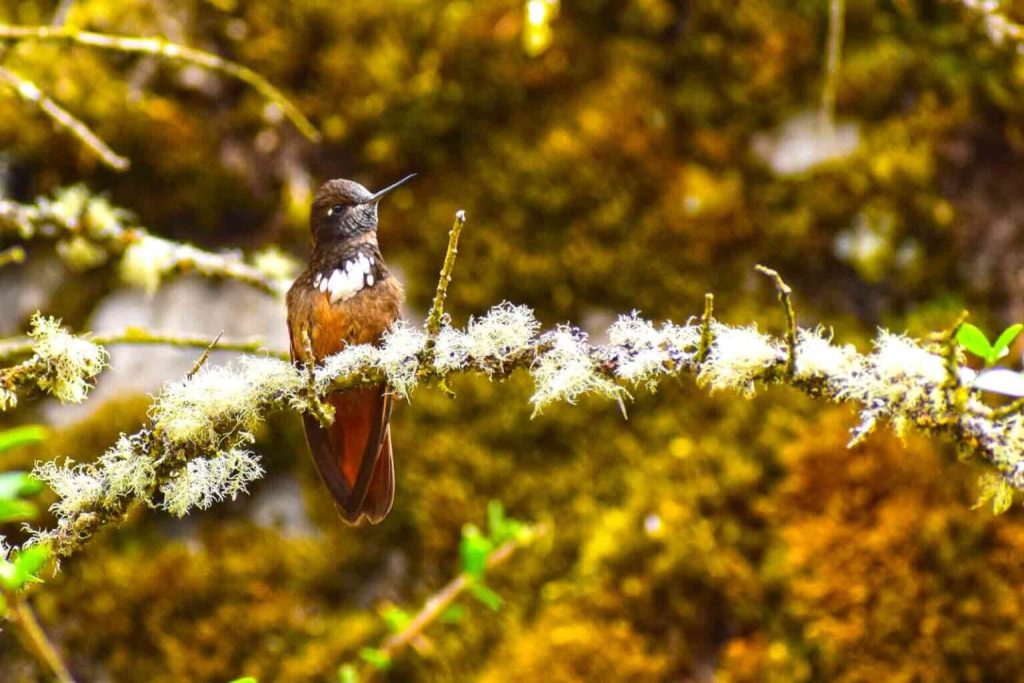
Peñas Sector – Montane Scrub and Hidden Treasures
The Peñas area, located on the approach to the pass, is dominated by dense semi-humid montane scrub. It’s a great place to wander along trails or simply bird from the roadside, with excellent opportunities to observe a wide range of Andean species. For those spending more time here, hiking up to higher elevations on the nearby hills can yield even more discoveries.
Frequently observed species:
- White-tufted Sunbeam
- Shining Sunbeam
- Great Sapphirewing
- Creamy-crested Spinetail
- Rusty-fronted Canastero
- Black-throated Flowerpiercer
- Cinereous Conebill
Occasional visitors:
- Junín Canastero
- Bearded Mountaineer
- Tit-like Dacnis
- Chestnut-breasted Mountain-Finch
Abra Málaga Pass – A Stronghold for Polylepis Specialists
At the highest point of the pass, Abra Málaga is a must-visit for anyone interested in Polylepis specialists—birds adapted to life in these rare, high-altitude woodlands. The star attraction is undoubtedly the Royal Cinclodes, a critically endangered species with an estimated population of only around 200 pairs remaining.
Other notable residents include the White-browed Tit-Spinetail, Ash-breasted Tit-Tyrant, and Giant Conebill, all species that depend on the survival of Polylepis forests. The area also features open puna meadows and grasslands, where Andean waterfowl and raptors can be observed.
Common species:
- Andean Goose
- Giant Conebill
- Tit-like Dacnis
Uncommon species:
- Blue-mantled Thornbill
- Purple-backed Thornbill
- Line-fronted Canastero
- Puna Thistletail
- Streak-throated Canastero
- Tawny Tit-Spinetail
- White-browed Tit-Spinetail
- Stripe-headed Antpitta
- Puna Tapaculo
- Ash-breasted Tit-Tyrant
Rare but remarkable records:
- Andean Condor
- Andean Ibis
- Puna Snipe
- Royal Cinclodes
- Junín Canastero
- Unstreaked Tit-Tyrant
Why Visit
- One of the few sites to see Peruvian endemics like the Royal Cinclodes.
- Spectacular views of snowcapped Veronica Mountain.
- Birding is possible year-round, but mornings are best for activity.
3. Machu Picchu
Location: 112 km northwest of Cusco (accessible by train or Inca Trail).
Altitude: 2,400 m
Recommended time: 2-4 days
Known worldwide as one of the New Seven Wonders of the World, Machu Picchu is not only a masterpiece of Inca architecture but also an extraordinary destination for birdwatching. Its unique location—at the junction between the eastern Andes and the upper Amazon rainforest—creates an exceptional variety of habitats, from humid subtropical forests to high mountain slopes.
Since explorer Hiram Bingham first brought Machu Picchu to the world’s attention, this mysterious Inca citadel has become Peru’s most visited destination. While its archaeological importance is undeniable, few visitors realize that it’s also an excellent birdwatching site. Combining a visit to the ruins with birding is a rewarding experience, and staying one or two nights in the area allows time to explore its rich surroundings.
The lush forests around the ruins are the best places to find the Inca Wren, a species found nowhere else on Earth, as well as the shy Parodi’s Hemispingus. Many travelers on their way to Manu spot their first Andean Cock-of-the-Rock along the railway near Aguas Calientes, and Torrent Ducks can often be seen navigating the fast-flowing Urubamba River.
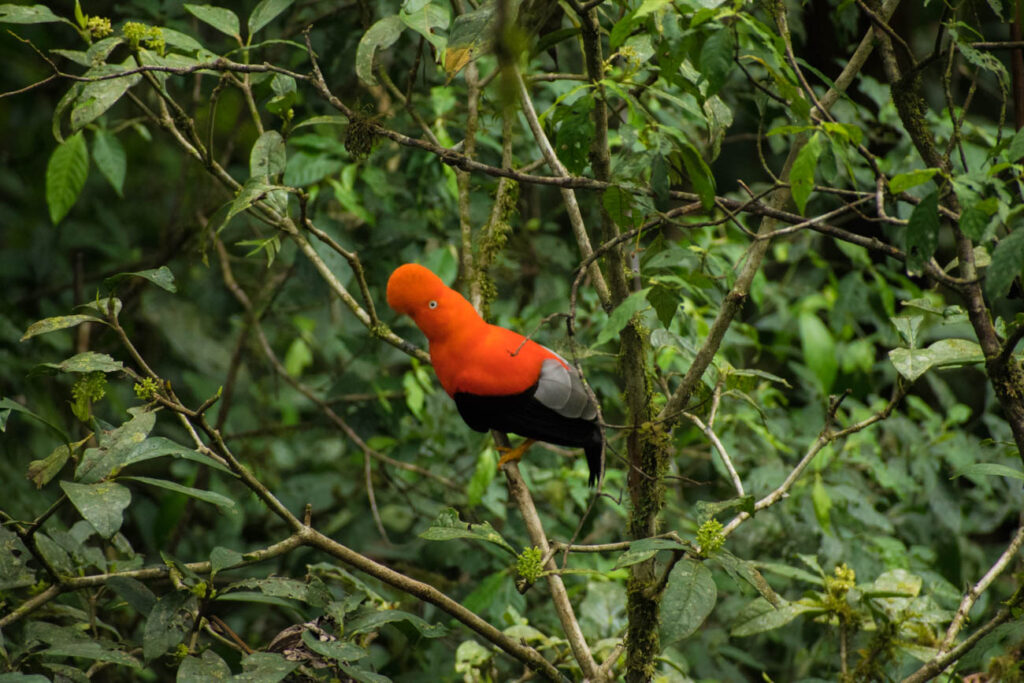
Because Machu Picchu is such a popular destination, advance booking is highly recommended—accommodation tends to fill up quickly, especially during peak season.
Inside the archaeological site itself, birders should watch for Streak-throated Bush-Tyrant, White-winged Black-Tyrant, and keep scanning the skies for White-collared and White-tipped Swifts, or even a Peregrine Falcon. On rare occasions, a majestic Andean Condor can be seen soaring above the mountains opposite Huayna Picchu.
Common species: White-winged Black-Tyrant, Streak-throated Bush-Tyrant, Inca Wren, Cusco Brushfinch, Tricolored Brushfinch, Speckle-faced Parrot.
Rare species: Andean Condor, Peregrine Falcon.
Aguas Calientes
At dawn, walk east along the train tracks downstream from Aguas Calientes. After passing the old Puente Ruinas train station, continue for about 2 km — this is a reliable area to find the Andean Cock-of-the-Rock. The same trail offers excellent opportunities to observe montane forest species such as Andean Motmot, Sclater’s Tyrannulet, Bolivian Tyrannulet, and Silvery Tanager.
A highly recommended stop for birders is the Machu Picchu Pueblo Hotel (now Inkaterra Machu Picchu Pueblo Hotel), where beautifully landscaped gardens and well-maintained feeders attract a dazzling variety of hummingbirds, including the Green-and-white Hummingbird, a regional endemic. Short forest trails on the property can reward you with species like Ocellated Piculet, Capped Conebill, Andean Motmot, Sclater’s Tyrannulet, and even Andean Cock-of-the-Rock.
If nearby trees are fruiting—especially the avocado groves—you may encounter White-eared Solitaire, Masked Trogon, or, with luck, a brilliant Golden-headed Quetzal.
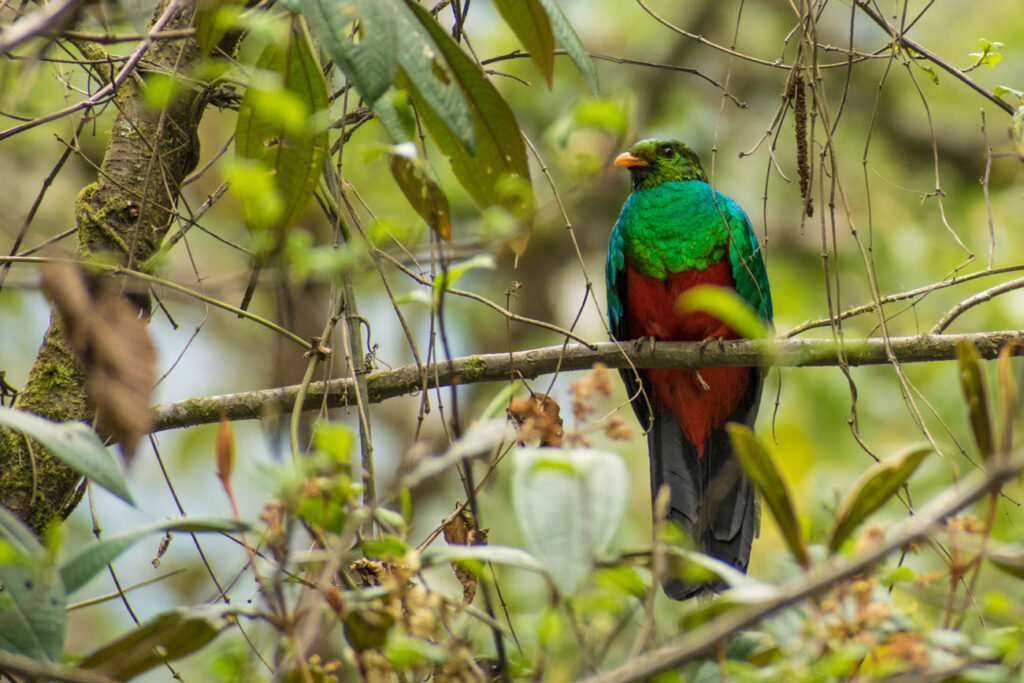
Common species: Torrent Duck, Mitred Parakeet, Yungas Pygmy-Owl, White-bellied Hummingbird, Green-and-white Hummingbird, Andean Motmot, Ocellated Piculet, Variable Antshrike, Andean Cock-of-the-Rock, Masked Fruiteater, Inca Flycatcher, Sclater’s Tyrannulet, Inca Wren, Silvery Tanager.
Birding Highlights
The surrounding forests host more than 400 recorded bird species, making it one of the richest birding areas in the Cusco region. Some of the most sought-after species include:
- Andean Cock-of-the-Rock (Rupicola peruvianus) – Peru’s national bird, often seen displaying at dawn.
- Green-and-white Hummingbird (Elliotomyia viridicauda) – an endemic species found only in the Urubamba Valley.
- Inca Wren (Pheugopedius eisenmanni) – another Peruvian endemic, common along shaded forest trails.
- Masked Fruiteater, Versicolored Barbet, Torrent Duck, Andean Motmot.
The diversity is stunning: in a single day, birders can observe hummingbirds feeding among orchids, tanagers flocking in the canopy, and riverine species like Torrent Ducks navigating the fast-moving waters below.
Birding Routes Around Machu Picchu
- Mandor Valley: A short walk from Aguas Calientes, this trail follows the Urubamba River and offers excellent chances to see Inca Wrens, Tanagers, and Cock-of-the-Rock early in the morning.
- Hydroelectric Road: Extending beyond Machu Picchu Pueblo, this route is one of the best low-elevation sites for mixed flocks and tropical foothill species.
- Putucusi and the lower slopes of Machu Picchu Mountain: Ideal for those seeking panoramic views combined with forest birding.
When to Visit
The best months for birdwatching are April through November, when mornings are clearer and trails are easier to explore. Early hours (5:30–9:00 a.m.) are optimal for both activity and photography, as light filters beautifully through the misty forest.
Why Machu Picchu Stands Out for Birding
What makes Machu Picchu unique is the fusion of culture and nature. It’s one of the few places on Earth where you can spot rare hummingbirds, listen to the calls of tropical birds, and admire ancient Inca stonework—all within the same landscape. For travelers seeking a balance between adventure, history, and biodiversity, Machu Picchu is truly unforgettable.
4. Ensifera Garden – A Hummingbird Photographer’s Dream
Location: Sacred Valley, near Urubamba.
Altitude: ~2,800 m
Recommended time: 1 day – 1/2 day
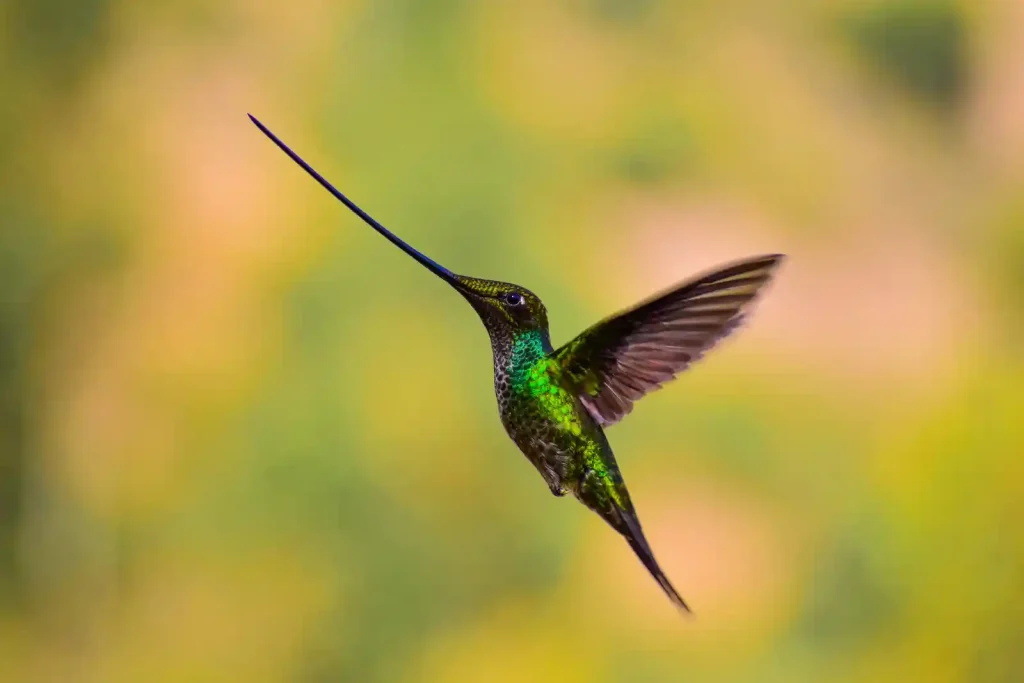
Ensifera Garden (also known as Ensifera Camp) is a private site with hummingbird feeders set in lush gardens. It was designed for bird photographers and offers the chance to observe species at close range.
Key Bird Species
- Sword-billed Hummingbird – unique worldwide for its bill longer than its body.
- Giant Hummingbird – the largest hummingbird in the world.
- Shining Sunbeam, Sparkling Violetear, White-tufted Sunbeam.
- Creamy-crested Spinetail
- Bearded Mountaineer
- Peruvian Pygmy-Owl
- Yellow-billed Tit-Tyrant
- Undulated Antpitta
- Rusty-fronted Canastero
- Up to 15 hummingbird species recorded regularly.
Why Visit
- Guaranteed hummingbird sightings year-round.
- Perfect for beginners, families, and photographers.
- Easy access in the Sacred Valley with nearby accommodation.
5. Manu Road – One of the World’s Greatest Birding Routes
Location: From Cusco through Paucartambo into Manu Biosphere Reserve.
Altitude Range: From 3,500 m to 500 m (Andes to lowland rainforest).
Recommended time: 3-15 days
The legendary Manu Road is considered one of the best birdwatching roads in the world. The route descends through diverse habitats, making it possible to see up to 600 species in a single trip.
Key Birding Stops
Wayquecha Biological Station (3,000–3,600 m) See ebird list
Perched at about 3,000–3,600 meters along the famous Manu Road, Wayquecha Biological Station marks the transition between Andean grasslands and lush cloud forest. Managed by the Asociación para la Conservación de la Cuenca Amazónica (ACCA), it serves both as a research center and a prime spot for birdwatching. The area is rich in high-Andean and montane forest species, with moss-covered trees, orchids, and constant mist creating an enchanting atmosphere.
Notable birds include the Hooded Mountain-Tanager, Barred Fruiteater, Golden-collared Tanager, and several colorful hummingbirds that frequent the feeders around the station. Comfortable lodging and well-maintained trails make Wayquecha an ideal base for exploring the upper section of the Manu Road.
- Montane forest, orchids, and mossy trees.
- Birds: Blue-banded Toucanet, White-throated Antpitta, Green-and-white Hummingbird, Cuzco Brushfinch, White-throated Screech-Owl, Sword-billed Hummingbird, Inca Flycatcher, Masked Trogon, Montane Woodcreeper, Pearled Treerunner, Red-and-white Antpitta, Urubamba Antpitta, Shining Sunbeam, Hooded Mountain-Tanager.
Manu Magic Birds Garden (2,500–2,800 m) See ebird list
Manu Magic Birds is a specialized hummingbird and tanager garden located along the Manu Road, designed especially for bird photographers and nature enthusiasts. Set in the lush cloud forest of southeastern Peru, this private reserve attracts a remarkable diversity of hummingbirds, flycatchers, and colorful tanagers, offering close-up views and excellent photographic opportunities.
Feeders and flowering plants are carefully arranged to create natural perches and soft backgrounds, making it one of the best spots on the Manu Road for high-quality bird photography. The tranquil setting, constant bird activity, and accessibility from nearby lodges make Manu Magic Birds a must-visit stop for anyone exploring the Manu region.
- Mixed flocks of hummingbirds, tanagers, flycatchers, and woodcreepers.
- Notable birds: Rufous-capped Thornbill, Sapphire-vented Puffleg, Amethyst-throated Sunangel, Shining Sunbeam, White-rumped Hawk, Red-and-white Antpitta, Red-and-white Antpitta, Leymebamba Antpitta, Montane Woodcreeper, Tufted Tit-Tyrant, Spotted Tanager, Violet-fronted Brilliant, Golden-headed Quetzal, Solitary Eagle, Bronzy Inca, Rufous-booted Racket-tail, White-bellied Woodstar, Long-tailed Sylph, Amethyst-throated Sunangel, Violet-throated Starfrontlet.
San Pedro & Cock-of-the-Rock Lodge (1,400–1,600 m) See ebird list
Located at around 1,400–1,600 meters along the legendary Manu Road, the San Pedro area and Cock-of-the-Rock Lodge mark the transition from cloud forest to tropical foothills—one of the most productive birding zones in Peru.
This lush, humid forest is alive with bird activity from dawn to dusk. Visitors can easily spot Andean Cock-of-the-Rock (Rupicola peruvianus) at the nearby lek, as well as manakins, trogons, tanagers, toucans, and antbirds. The constant mist, tall ferns, and orchids create an atmospheric backdrop perfect for photography.
The Cock-of-the-Rock Lodge offers comfortable accommodations and forest trails, making it an ideal base for exploring the middle elevations of the Manu Biosphere Reserve.
- Lush cloud forest with high bird activity.
- Birds: Blue-fronted Lancebill, Golden-eared Tanager, Bananaquit, Torrent Duck, Lyre-tailed Nightjar, Crested Oropendola, Wire-crested Thorntail, Peruvian Piedtail, Green Hermit, Marcapata Spinetail, White-eared Solitaire, Versicolored Barbet, White-capped Dipper, Yungas Manakin, Blue-naped Chlorophonia,Masked Tityra, Inca Flycatcher, Amazonian Umbrellabird, Andean Cock-of-the-Rock, Andean Guan, Mitred Parakeet, Buff-rumped Warbler, Yellow-throated Chlorospingus, White-crested Elaenia, Bolivian Tyrannulet, Pygmy Antwren, Rufous-crested Coquette, Purple Honeycreeper, Violet-fronted Brilliant.
Manu Endemic Lodge & Reserve
Manu Endemic Lodge & Reserve is beautifully located in the transition zone between the cloud forest and the Amazon rainforest, one of the most biodiverse habitats on the Manu Road. The lodge combines comfortable accommodation with excellent opportunities for birdwatching and nature photography.
Its network of forest trails allows visitors to explore pristine habitats rich in tanagers, flycatchers, antbirds, and trogons. Around the lodge, a carefully designed garden with feeders and flowering plants attracts an impressive variety of hummingbirds and colorful tanagers, providing close-up views and ideal conditions for photography.
This site is perfect for birders looking to enjoy the lower elevations of the Manu region while experiencing the unique mix of Andean and Amazonian species that make this area world-famous.
- Transition to Amazon lowland birds.
- Birds: Peruvian Piedtail, Buff-tailed Sicklebill, Black-throated Mango, Rufous-crested Coquette, Andean Cock-of-the-rock, Amazonian Umbrellabird, Lyre-tailed Nightjar, Crested Quetzal, Yungas Manakin, Black Antbird.
Pico de Oz Hummingbird Garden See ebird list
Located at around 500 meters above sea level, near Pillcopata, Pico de Oz is a beautiful hummingbird and tanager garden along the lower section of the Manu Road. Designed especially for bird photographers and nature lovers, this peaceful garden is surrounded by tropical vegetation and features numerous feeders and flowering plants that attract a vibrant variety of species.
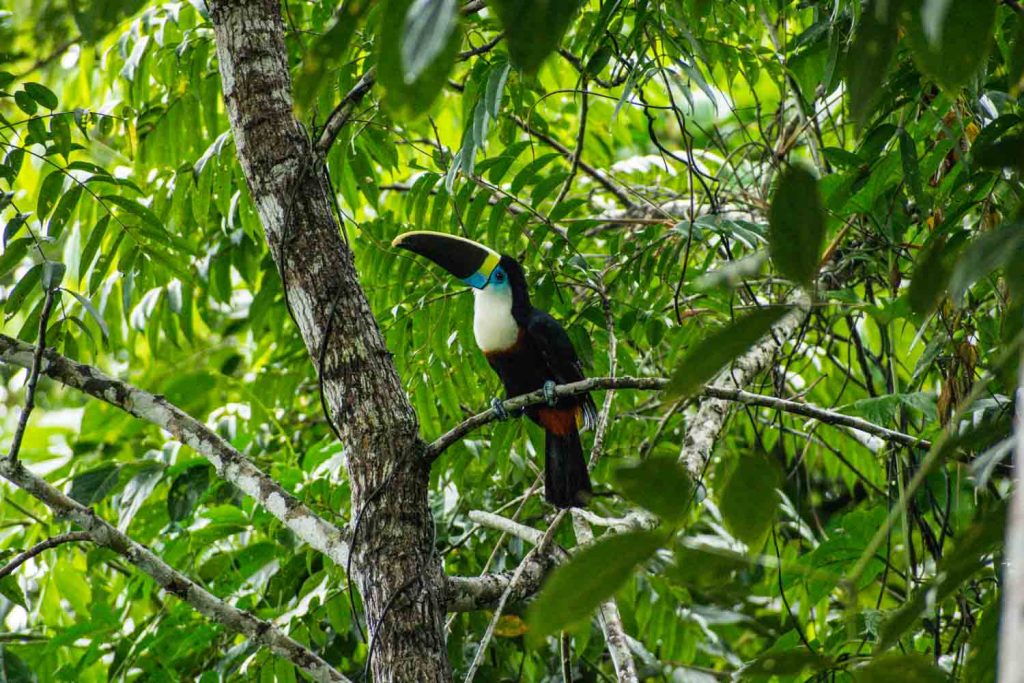
Visitors can enjoy close encounters with dazzling hummingbirds, colorful tanagers, and active flycatchers, making Pico de Oz one of the best lowland sites for birdwatching and photography in the Manu region.
- Amazon lowland birds.
- Birds: Buff-tailed Sicklebill, Rofous-crested Coquette, Peruvian Recurvebill, White-throated Toucan, Russet-crowned Crake, Amazonian Antpitta, Uniform Crake, and mixed flocks.
Inkamazonia Garden (500 m) See ebird list
Situated near Pillcopata, at the foothills of the Manu Biosphere Reserve, Inkamazonia Garden is a peaceful birdwatching and photography garden surrounded by tropical forest. Located at around 500 meters above sea level, it offers an ideal environment where hummingbirds, tanagers, and flycatchers gather to feed on flowering plants and well-maintained feeders.
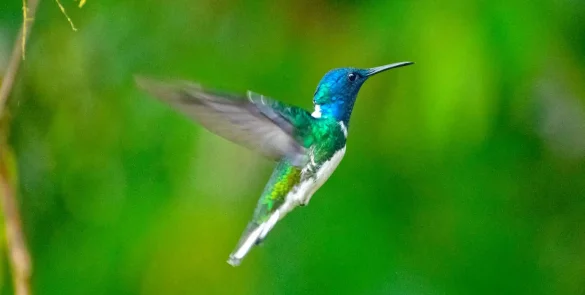
Designed with photographers in mind, the garden provides excellent light conditions, natural perches, and constant bird activity throughout the day. Its combination of accessibility, comfort, and incredible diversity makes Inkamazonia Garden one of the best spots along the lower Manu Road to observe and photograph Amazonian and foothill bird species.
- Amazon lowland birds.
- Birds: White-necked Jacobin, Buff-tailed Sicklebill, Koepcke’s Hermit, Amethyst Woodstar, Golden-tailed Sapphire, Undulated Tinamou, Bluish-fronted Jacamar, Orange-bellied Euphonia, Koepcke’s Hermit, Koepcke’s Hermit.
Why Visit
- Ranked among the top 5 birding routes globally.
- Opportunities to combine birding with nature lodges.
- Close to Manu National Park, a UNESCO World Heritage Site.
6. Additional Birding Hotspots in Cusco Region
- Sacred Valley riverbanks – Torrent Ducks, Andean Flickers, White-capped Dippers.
- Polylepis forests near Paucartambo – rare habitat for specialists.
- Cusco city outskirts – urban birding with species like Andean Gull and Rufous-collared Sparrow.
7. Why Birdwatching in Cusco is Unique
Cusco offers one of the highest biodiversity gradients in the world. Within a few hours’ drive, you can move from alpine grasslands at 4,000 m to Amazonian rainforest at 500 m. This diversity means that birders can:
- See endemics only found in Peru.
- Photograph rare hummingbirds in close range.
- Observe a mix of Andean and Amazonian species in a single trip.
- Enjoy birding combined with archaeological wonders like Machu Picchu.
8. Practical Tips for Birdwatchers
- Best Season: April to November (dry season), though birding is good year-round.
- Transport: Car rentals or private tours; some sites accessible by public transport.
- Gear: Binoculars (8×42 or 10×42), spotting scope for wetlands, rain gear.
- Guides: Hiring local birding guides increases chances of spotting rare species.
- Field Guides: Birds of Peru (Schulenberg et al.) is the standard reference.
Birdwatching in Cusco is an adventure that combines stunning landscapes, cultural history, and extraordinary biodiversity. Whether you’re spending a morning at Huacarpay, chasing hummingbirds in the Sacred Valley, or embarking on the legendary Manu Road, Cusco will reward you with unforgettable encounters.
With over a thousand species waiting to be discovered, Cusco truly is a world-class destination for bird lovers.
👉 Start planning your birdwatching journey in Cusco and experience one of the richest birding regions on the planet.
